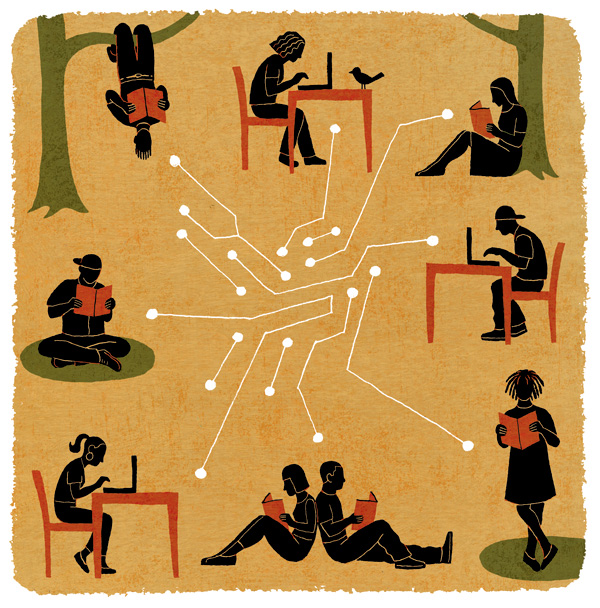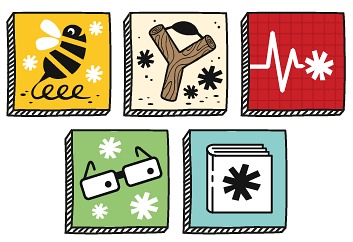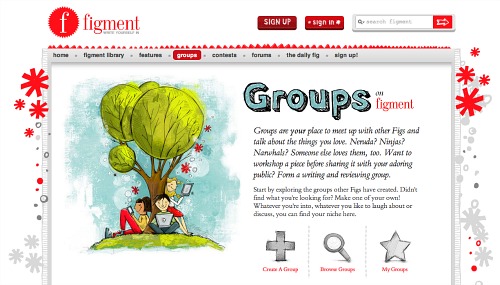
Illustration by James Steinberg
| In this Article |
| Using Figment in School |
Rory Schrobilgen isn’t sure if being a published writer is his life’s ambition. But for now, the 13-year-old is doing just that—posting short stories and novels on Figment.com, where his writings reach scads of readers far beyond his family and friends in Oak Park, IL.
Schrobilgen joined the teen writing community in December 2010 after hearing about it from a friend, and counts on its feedback to improve his pieces, which include Inquiry, a dystopian novel-in-progress about two teens living in an abandoned city with no memory of how they got there.
“Just the feeling that someone in the world can read your writing and enjoy it, that’s cool,” says Schrobilgen, who enters ninth grade at Oak Park and River Forest High School this fall. “It’s a taste of being a published author even if I don’t grow up to be one.”
Schrobilgen isn’t the only budding fiction writer who’s hooked on Figment. Since Jacob Lewis (a former managing editor of the New Yorker and of Portfolio, a Condé Nast magazine that folded in April 2009) and Dana Goodyear (a current staff writer for the New Yorker) launched Figment on December 5, 2010, roughly 250,000 registered users have flocked to the free writing platform. (The site attracted 4,000 teens on its first day.) Kids ages 13 and older now routinely add about 1,000 stories each day to the site and critique their peers’ works.
Figment gained many of its users in February, when it purchased HarperCollins’s Inkpop, a rival teen-writing site, and welcomed its 95,000 members aboard. But a good chunk of the site’s growth has also come from librarians and teachers who see the space as a perfect way to breathe new life into dreary writing assignments or staid writing groups, which often don’t cut it with today’s social media- and digital content-savvy kids.
Figment’s creators teamed up with libraries and schools early on. “Given that we were becoming a place where teens and young adults were excited to spend time reading and writing, it seemed natural to partner with librarians and other educators to capitalize on that excitement and direct some of it toward educational settings—to really take advantage of Figment as a potential teaching tool,” says Katie Robbins, Figment’s former vice president of partnerships and director of educational programming.
The site produces a bimonthly educator newsletter that reaches more than 4,000 subscribers and includes tips on how to work Figment into their programs. For example, a recent lesson on Printz Award–winner Meg Rosoff’s new novel, There Is No Dog (Putnam, 2012), encourages students to “think sideways” by reinterpreting a favorite story.

Maggie Stiefvater
Figment understands its young audience well. It’s partnered with HuffPost Teen, where a Figment piece appears each week, and, Lewis says, Figment ran its famous fiction contest in Seventeen magazine last year. The competition attracted about 5,000 entries and more than 37,000 votes. The winner, Alexandra K., earned a $5,000 cash prize, had her story published on Seventeen’s website, and received a phone call from one of the judges, Maggie Stiefvater, the author of The Scorpio Races (Scholastic, 2011), a Printz Honor book.
Even Figment’s homepage is inviting, covered in doodles that teens may have scribbled on their old-school notebooks at home. Figment has also birthed a small graphic-design industry, where would-be art directors eagerly create covers for other community members for free or barter. Plus, young J. K. Rowlings don’t sacrifice their copyrights by sharing—anything they post, they own. However, the sharing is what drives them—and educators—there in the first place, says Lewis. “One of the wondrous qualities of the site is people feel free and liberated enough to share their work, because there’s a feel of legitimacy in publishing something and sharing it with tens of thousands of people,” he says. “That can be a powerful force.”
Teens also respond favorably to having their writing critiqued—granted, the community is generally gentle and supportive in its approach—and the site acts as a virtual writing mentor to young hopefuls. Just ask Jordan Allen. “There’s a poem I wrote, which [members] asked me to expand on as a story,” says the 18-year-old senior at Roseville High School in Michigan, who started using Figment primarily for her poetry. “But I was horrible at it. They kept pushing me to write more, and write more in-depth, and it was definitely helpful in getting me to the final product.”
In addition to its main site, Figment also offers Figment Groups, a private space where students can share their works—but with a preselected group of users. Only educators can sign up and create a Figment Group—but teens who join are still members of the entire Figment site and can decide if and when to share their work with the wider community.
To cultivate her kids’ writing chops, Alexis Skidmore, a library assistant at Palomino Library, a branch of Arizona’s Scottsdale Public Library, launched a Figment Group for her teens, where she posts writing prompts and encourages them to write book reviews and enter contests the site runs periodically. “They gravitate to the flash fiction ones because they’re fast and they have big-name authors involved that the students recognize,” says Skidmore of the brief stories that usually run 1,000 words or less.
 Of her group’s 22 members, seven still use the site, and Skidmore finds they love the immediate response it offers, not to mention the fun they have earning virtual badges (pictured) such as Bookworm, Critic, and Inkslinger for publishing stories, and adding the badges to their online profiles.
Of her group’s 22 members, seven still use the site, and Skidmore finds they love the immediate response it offers, not to mention the fun they have earning virtual badges (pictured) such as Bookworm, Critic, and Inkslinger for publishing stories, and adding the badges to their online profiles.
Skidmore’s library is housed on the campus of Desert Mountain High School (which Newsweek recently named one of the best schools in the country), giving her more access to local teens, since the space also doubles as their school library. She anticipates that more students will join her group during the coming school year, but they just haven’t turned in their permission slips yet. “They’re wonderful, but paperwork is not their strong suit,” she says, laughing.
Figment’s Robbins says the group feature not only allows students to create first drafts before they’re ready to share with the community at large, but also offers library staffers like Skidmore a way to run more tailored contests, give helpful feedback, or just interact with their students and patrons privately. “Ultimately the groups really are a kind of blank canvas that can be used in a really wide variety of ways and for different kinds of projects,” says Robbins. These include schools using groups to workshop pieces collectively, classes sharing pieces of historical fiction based on historical characters, and a New York youth-mentoring organization, Girls Write Now, which uses the groups to turn their writing into digital pieces using video and images.
Many librarians and teachers come to the site through their students, but also through cross marketing with groups including Edutopia, the New York Times Learning Network, the American Association of School Librarians, and the Young Adult Library Services Association, which recently teamed with Figment to create a private group to talk about the finalists for the 2012 Teens’ Top Ten.
Kim Bewick, a youth librarian at Strathcona County Library in Sherwood Park, Alberta, Canada, turned to Figment to give teens a way to talk about the books they’re reading, post online book reviews, and take part in her library’s Teen Summer Reading Game, where kids win prizes for reading and reviewing books.
While just 15 teens had signed up for the Figment portion of the games by the end of the first week, Bewick expects more members as weeks progress, and students are already posting reviews and bantering in the forum areas. She hopes many will stay on to connect through the site’s online forums. Bewick particularly likes that she, or any teacher or librarian that starts Figment Groups, can monitor them, that they’re available 24/7 to students, and that strangers can’t intrude. “We are extremely excited about having a space dedicated to books and writing for our teens that is available to them on their terms and their time,” says Bewick, by email. “The library doesn’t have the capacity to be open 24/7 at this point, but with online forums the teens can engage at any time. And we’re really excited about that.”

The level of control that Figment Groups provide lets librarians and other educators offer kids a certain degree of handholding as they get started—even removing comments or posts that aren’t in keeping with the spirit of the group. Dawn Hall, a part-time teen and tween librarian at Colebrook Public Library in New Hampshire, just launched a Figment Group for her teen reading group. She’d considered building a wiki space, but loved Figment’s content—and the discretion it gave her. “I wanted them to be their own group where there wouldn’t be kids signed up if they weren’t in the program,” she says. “Also, I have control of blocking them from posting anything inappropriate.”
Certainly not all teens are destined for literary stardom or want to craft stories for strangers to read, but educators eager to engage today’s digital natives are finding Figment a fun way to handle English assignments or to get them involved in a library group. Plus, for many teens, the site offers a chance to strengthen and nurture their writing skills—and gives them a taste of real-world readers.
“I prefer Figment criticism to real life,” says Schrobilgen. “There’s something [special] about the Figment community because no one is going to tell you you’re terrible. They’re going to be polite and give you tips on how to get better. There are some people who read every chapter of my novel as I write them, and that’s nice. They’re with you every step of the way.”
Thinking about using Figment in your school?
Try these tips from teachers, librarians, and the folks at Figment:
1. Teachers and librarians say that while Figment is fun, educators should still come up with an assignment that tweaks the norm. Think Harry Potter fan fiction, flash stories, short pieces influenced by an image or piece of music, or even entries for one of Figment’s occasional writing contests.
2. As with any use of online media, a lesson on privacy issues and safe surfing is key. Students should be cautioned about posting too much personal information—perhaps using only first names and not mentioning the city where they live.
3. Make a decision early that if you launch a closed group, students know when you’re comfortable with them sharing their work with the larger community, and how long you’d like them to stay within the virtual class space.
4. Finally, to ensure that all students feel read and evenly critiqued, teachers and librarians can assign teens to read one another’s work—so all teens get to experience that first comment or two.


